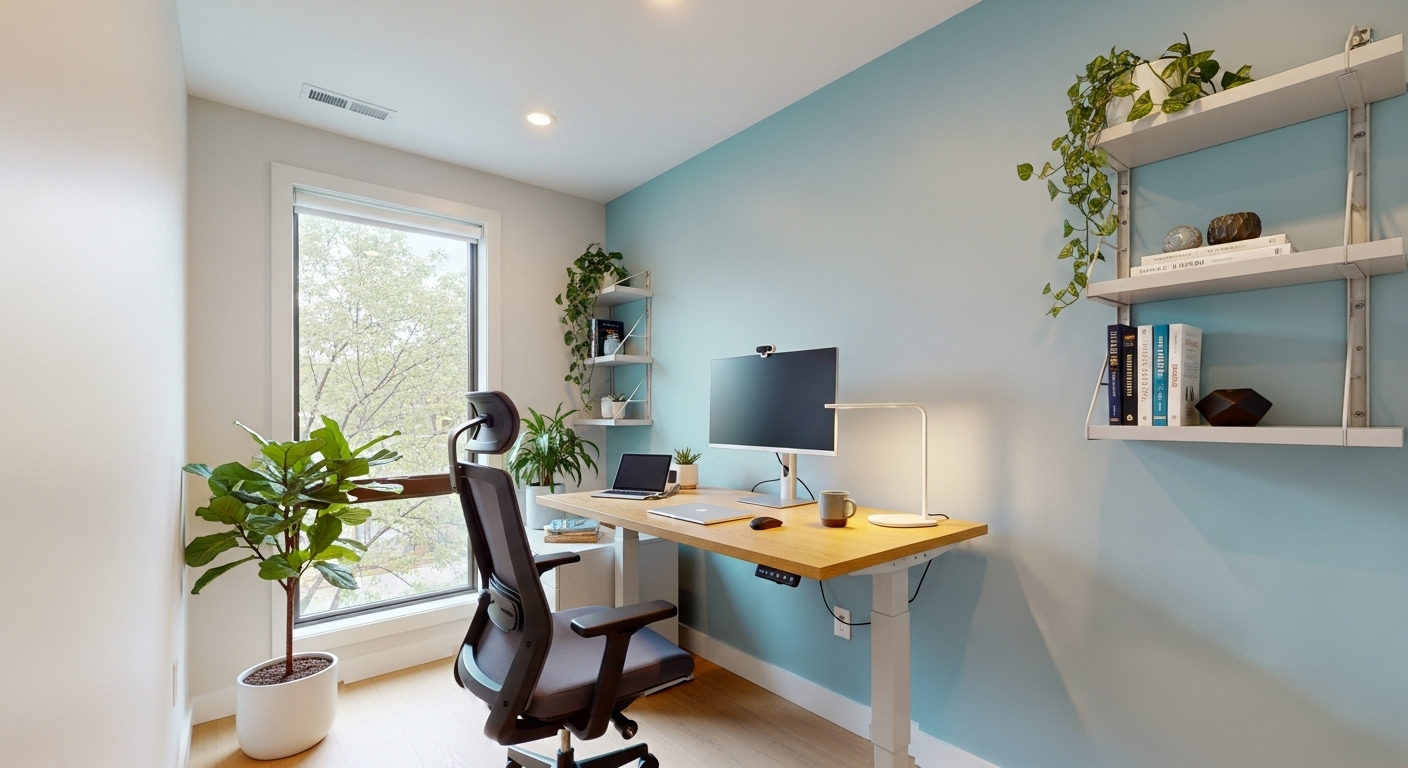Coworking spaces present a modern paradox: they are vibrant hubs designed for professional achievement, yet they are often filled with the very things that hinder it—noise, movement, and social interruptions. Many professionals approach this environment defensively, armed with headphones and a steely resolve to block everything out. But what if this background hum of activity isn’t a bug, but a feature? This is the principle of the ‘Ambient Advantage’—the idea that the collective energy of a shared workspace can be harnessed and channeled into fuel for focus and productivity. Instead of fighting against the current of your environment, you can learn to swim with it. This guide moves beyond simple distraction-blocking tactics. We will explore how to decode your personal work style, architect a sensory bubble, align your schedule with the natural rhythm of the space, and strategically leverage the community not as a distraction, but as a catalyst for your best work. Prepare to transform your coworking experience from a battle for focus into a source of unparalleled professional momentum.
Decoding Your Productivity Profile
Before you can harness the energy of a coworking space, you must first understand your own internal operating system. Productivity isn’t a one-size-fits-all concept; it’s deeply personal. The first step is to conduct a self-audit to decode your unique productivity profile. Are you energized by the low hum of background activity, or do you require near-perfect silence for deep concentration? Consider your chronotype: are you a ‘lark’ who does their best work in the quiet early morning hours, or a ‘night owl’ who hits their stride when the afternoon rush subsides? Track your energy and focus levels for a full work week. Note when you feel most engaged and when your mind starts to wander. This data will reveal crucial patterns about how you interact with your environment. For example, you might discover your creativity peaks mid-morning when the coffee machine is buzzing, but analytical tasks demand the solitude of late afternoon. Understanding this profile is the foundation for every other strategy. It informs where you choose to sit—a high-traffic hot desk versus a quiet corner nook—and how you structure your day. This self-awareness allows you to move from a reactive state, constantly battling distractions, to a proactive one, intentionally placing yourself in the right part of the space at the right time to match your task and energy level.
Crafting Your Sensory Bubble: Mastering Sight and Sound
Once you understand your personal needs, the next step is to consciously engineer your immediate surroundings to meet them. This is about creating a ‘sensory bubble’ that allows you to control your inputs and maintain focus. For sound, noise-canceling headphones are the most obvious tool, but their application can be more nuanced. Don’t just block noise; replace it. Experiment with different soundscapes to find what enhances your concentration. For some, the gentle, patternless hiss of white or brown noise is ideal for masking conversations. For others, binaural beats can help induce a state of flow, while instrumental music or curated focus playlists provide a stimulating but non-distracting audio backdrop. Paradoxically, ‘coffeeshop sounds’ apps can provide the comforting hum of activity without the sharp, unpredictable interruptions of a real space. On the visual front, minimizing unplanned stimuli is key. If possible, position your laptop so you face a wall or a window with a static view. If you’re in an open area, a portable monitor privacy screen is an invaluable investment. It not only protects your information but also creates a visual barrier that signals to others that you are engaged in focused work. Furthermore, practice digital and physical minimalism at your own desk. A cluttered screen with dozens of open tabs and a desk littered with papers creates a constant low-level visual stress. By mastering your auditory and visual inputs, you build a fortress of focus, allowing the ambient energy of the space to remain a background hum rather than a direct intrusion.
Time-Blocking and Strategic Scheduling
Managing your environment is only half the battle; managing your time within that environment is what truly unlocks peak performance. The key is to work with the natural ebb and flow of the coworking space, not against it. Use the insights from your productivity profile to implement strategic scheduling. Align your most demanding, deep-work tasks with the space’s quietest periods—typically early mornings, lunchtime, or late afternoons. Reserve the high-traffic, high-energy hours for shallow work like answering emails, administrative tasks, or planning. This simple alignment dramatically reduces the friction between your goals and your surroundings. A powerful technique for enforcing this structure is time-blocking, where you schedule every part of your day, including breaks, into your calendar. This creates a clear roadmap and reduces decision fatigue. For focused sprints within these blocks, the Pomodoro Technique is exceptionally effective in a coworking setting. Working in 25-minute focused intervals followed by a 5-minute break creates a rhythm that is resilient to minor interruptions. Critically, you must also schedule your social time. Instead of allowing random chats to derail your flow, intentionally use your breaks to walk to the kitchen, grab a coffee, and connect with fellow members. This satisfies the social impulse on your own terms and transforms potential distractions into rewarding, scheduled pauses that can actually boost your energy and creativity for the next block of focused work.
The Social Architecture: Networking Without Derailing Your Day
One of the primary draws of a coworking space is the vibrant community. It’s a powerful asset for collaboration, learning, and opportunity. However, this social element is also the biggest potential productivity killer if left unmanaged. The goal is to build a social architecture that allows you to benefit from the community without sacrificing your workflow. It starts with setting clear, non-verbal boundaries. The simple act of putting on your headphones is the universal sign for ‘I’m in the zone.’ Consistently honoring this signal for yourself—and respecting it in others—helps establish a culture of mutual respect for deep work. You can also define your availability more explicitly. Think of it as creating ‘office hours’ for yourself. When you’re available for a chat, leave your headphones off, work from a communal table, or take a break in the lounge area. This intentionality shifts you from being passively available for interruption at all times to being actively available at specific times. When you do engage, be mindful. A quick question is different from a 30-minute conversation. Learn to politely table longer discussions by saying something like, “That’s a great point. I’m in the middle of something right now, but could we grab coffee later to talk about it?” This validates the other person while protecting your focus. By designing your social interactions, you transform the community from a random variable into a scheduled, value-added component of your professional life.
Leveraging Community as a Productivity Multiplier
Beyond simply managing social interactions, you can actively leverage the coworking community to enhance your productivity. This is where the ‘Ambient Advantage’ truly shines. Think of the space as a living, breathing resource library. The graphic designer two desks away might have the perfect solution for a visual problem that’s been stalling your project. The marketing strategist in the lounge could offer a fresh perspective on your go-to-market plan. The key is to shift your mindset from viewing others as potential distractions to seeing them as potential collaborators and force multipliers. A powerful, often subconscious, benefit of this environment is the concept of ‘body doubling.’ This psychological phenomenon describes how the mere presence of others working around you can increase your own focus and accountability. Simply being in a room of productive people can motivate you to stay on task. You can take this a step further by creating informal accountability partnerships. A quick morning check-in with a fellow coworker—’What’s your main goal for today?’—can create a powerful commitment device. Furthermore, use the community to break through creative or technical blocks. Instead of spending hours stuck on a problem, consider a 10-minute ‘brain trust’ session with a couple of trusted peers. The diversity of thought in a typical coworking space is immense, and tapping into it can save you hours of solitary struggle. This proactive engagement turns the collective energy of the space into a tangible tool that actively accelerates your work.
The Tech Toolkit for a Fortified Focus
While mindset and scheduling are foundational, the right technology acts as the scaffolding that supports your productivity structure. Your tech toolkit should be curated to help you control your digital environment, enhance your focus, and work more efficiently within the flexible nature of a coworking space. Beyond noise-canceling headphones, consider focus applications like Freedom or Cold Turkey. These tools allow you to block distracting websites and applications for set periods, creating an impenetrable digital fortress during your deep work blocks. This removes the temptation and willpower drain of constantly fighting digital lures. Project management software like Asana, Trello, or Notion is also critical. By externalizing your tasks and projects onto a structured platform, you reduce your cognitive load, freeing up mental bandwidth for complex problem-solving. A well-organized digital task list provides clarity and momentum. Don’t overlook your physical tech setup. Investing in a lightweight, portable second monitor can revolutionize your coworking productivity. It allows you to create a proper dual-screen workstation anywhere, reducing eye strain and improving workflow for tasks that require referencing multiple documents. A comfortable, ergonomic portable mouse and keyboard can also prevent fatigue and make long work sessions more sustainable. This complete tech toolkit—encompassing audio, software, and hardware—allows you to build a consistent, high-performance workspace no matter which desk you’re at for the day, ensuring your focus remains fortified and your output high.
Conclusion
Thriving in a coworking space isn’t about building higher walls. It’s about learning to open the right doors at the right times. The journey to peak performance in a shared environment begins with deep self-awareness—understanding your personal rhythms and needs. From there, you can architect a personal sanctuary by mastering your sensory inputs, creating a bubble of focus amidst the buzz. By strategically scheduling your tasks to harmonize with the energy of the space and structuring your social interactions, you reclaim control over your day. The true power of the ‘Ambient Advantage,’ however, is unlocked when you move from a defensive posture to an offensive one. It’s about proactively leveraging the collective intelligence and motivational energy of the community, turning the presence of others into a productivity multiplier through accountability, collaboration, and the simple psychological boost of shared endeavor. Complemented by a smart tech toolkit, these strategies transform the coworking environment from a potential liability into your greatest asset. You no longer need to fight the chaos. Instead, you can learn to conduct it, channeling the vibrant, ambient energy of your workspace into a symphony of sustained, high-quality output and professional growth.





